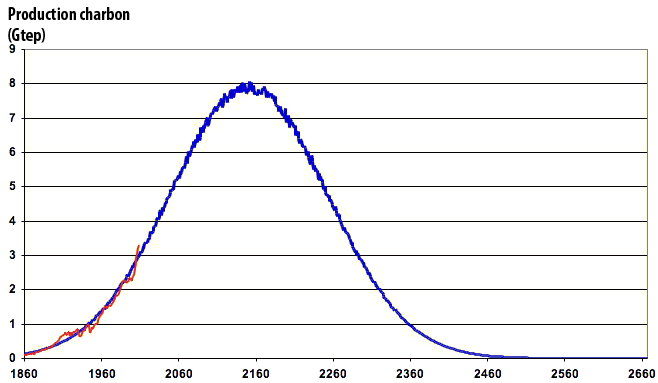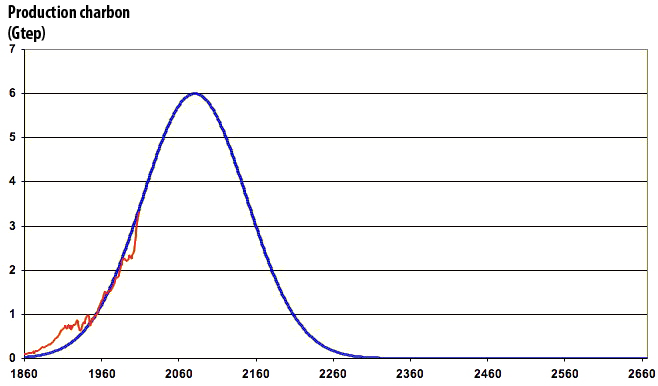No special treatment among fossil fuels: coal will also have a production peak ! The reason is that coal satisfies the same criteria than oil:
- coal formation requires hundreds of millions of years, and therefore we can consider that on historical times (a couple centuries) the coal stock underground – coal in place – is given once and for all,
- the extratible stock (the ultimate reserves) is a fraction of the coal in place (probably something like a quarter) ; it therefore has an upper limit,
- the cumulated coal extraction (coal “production”) from the beginning of times to the end of times will never go over the extractible stock (also named “recoverable resource” or “ultimate reserves”).
As for oil, as soon as we have a function (the annual extraction) for which the cumulative value from begining to end cannot go over a known value, then mathematics impose that this function must start from zero, end at zero, and will go through a maximum – the peak – in between. And as for oil, if the only constraint is geological, the date and the level of the peak depend mostly on the hypothese made on the overall amount of recoverable coal.
But we will face here two additional elements of complexity:
- the first one comes from the fact that coal is mostly a domestic or regional energy, and therefore the world peak, that will exist for sure, will not induce an homogeneous situation for all countries (which is more the case for oil, that has always a significant share in the energy mix of a given country, and that can easily go from one country to another because of low transport costs),
- coal has the highest CO2 emissions per energy unit, and represents the highest stock of fossil carbon on Earth. It is therefore possible (and even wishful from my point of view !) to limit its use as much as possible, precisely not to wait for the geological constraint to limitate our emissions. As the example below will illustrate, in such a case the peak would happen much too late for us to avoid, decades or centuries later, a climate change that would be much too important for a couple billion humans to adapt in acceptable conditions.
And at last we can also imagine that humanity begins its collapse (that will eventually come, the only question is when !) for a set of reasons in which a limit on the remaining recoverable coal or climate change would have little to do.
What follows has therefore an indicative value, to discuss when such an event could happen, but absolutey not a predictive value.
World peak
We will now assume the following hypotheses:
- the world coal production will follow, as for oil, a kind of bell-shaped curve,
- the cumulated coal production from beginning to end is equal (by definition) to the ultimate reserves,
- as the production curve is symetric, the production peak happens when we have mined half of the ultimate reserves,
- and, preferably, the simulation must match with the actual data for the past !
Even with this set of hypotheses, there is not only one solution to our problem, and here are two simulations that are plausible among many others that would also be. The first one is based on ultimate reserves that would amount to 2000 billion tonnes oil equivalent (between 3000 and 5000 billion tonnes of coal, depending on its quality), knowing that since 1860 the world production of coal has amounted to 160 billion tonnes oil equivalent.

Historical coal production (red), in billion tonnes oil equivalent, and possible coal production based on 2000 billion tonnes oil equivalent of ultimate reserves, in blue
The peak happens in 2150, with a yearly production of 8 billion tonnes oil equivalent (that is roughly 16 billion tonnes of coal). Note that the past production correctly matches the simulation
Source : Shilling et al 1977 & BP Statistical Review 2010 for the past production ; Reserves, Resources and Availability of Energy Resources 2007, annual Report, Federal Institute for Geosciences and Natural Resources, Germany for ultimate reserves.
But… we can also produce a plausible simulation with ultimate reserves that would amount to only half of the previous value, that is 1000 billion tonnes oil equivalent.

Same as above, for 1000 billion tonnes oil equivalent of ultimate reserves.
The peak would then be around 2080, with a yearly production of 6 billion tonnes oil equivalent (that is roughly 12 billion tonnes of coal).
Note that the past production still correctly matches the simulation.
Source : Shilling et al 1977 & BP Statistical Review 2010 for the past production ; Reserves, Resources and Availability of Energy Resources 2007, annual Report, Federal Institute for Geosciences and Natural Resources, Germany for ultimate reserves.
What these simulations suggest is that coal production, if we have only geological – thus technical and economical – limits, should peak “somewhere” between the second half of the 21st century and the first half of the next one. Even if this event can seem located in a remote future, this conclusion obviously contradicts a sentence often heard, which is that we have “3 centuries of coal”. Actually such a statement is as wrong as saying that we have “40 years of oil”, for exacty the same reasons.
And actually, some geologists consider that 1000 billion tonnes oil equivalent of recoverable coal is still excessive, and that the ultimate reserves would rather be just a little above the present proven reserves. Their point is that, contrary to what can be observed for oil or gas, some successive estimates on ultimate reserves give figures that rather go down than up.

Another simulation of the future coal production, in million tonnes oil equivalent, with ultimate reserves close to the present level of proven reserves.
The peak would then be in 2025 ! And for China it would happen around 2020 ; the Former Soviet Union (FSU) being the only zone able to sustain an important production till the end of the century.
Source : Coal, resources and future production, Energy Watch Group, 2007
All the elements above confirm (and it’s normal) that the peak is pretty dependant of the amount of ultimate reserves. The debate is open !
Regional peaks
As mentionned above, the world peak will hide local realities that will be very inhomogeneous. Coal does not travel well, and 90% of the resources are located in 8 countries only. Besides, coal transport is for the time being very dependant on oil, which will peak much before coal. Therefore when local production decreases, it is not always possible that imports can compensate. Europe, for example, imports coal since it has passed its production peak, but consumption is nevertheless decreasing.
European coal production, in orange, and consumption, in blue. Sources are mentionned on the site tsp-data-portal
Sources : Mentioned on the website
But… coal can be turned into liquids, easier to transport ! Definitely, but first half of the initial energy content of the coal is lost in the transformation process, then all the transport infrastructure (pipelines, harbors, boarding equipment) has to be built close to coal basins, which are not oil basins. All this is possible, but it is quicker said that done ! And, last but not least, it leads to important CO2 emissions. But… it is possible to sequestrate CO2 ! Yes, but it costs a little something, and most of all requires one quarter of the initial energy content of the coal….
At the end of the day, we realize that discussing on how coal still present here could be used to fill a gap there is more easily associated to fortune telling than to predictive science. The only conclusion we are reasonably assured of is that we will have a succession of local or regional peaks (Europe has already passed it) and that the last countries to have coal in large quantities will be the US and Russia. For the rest…